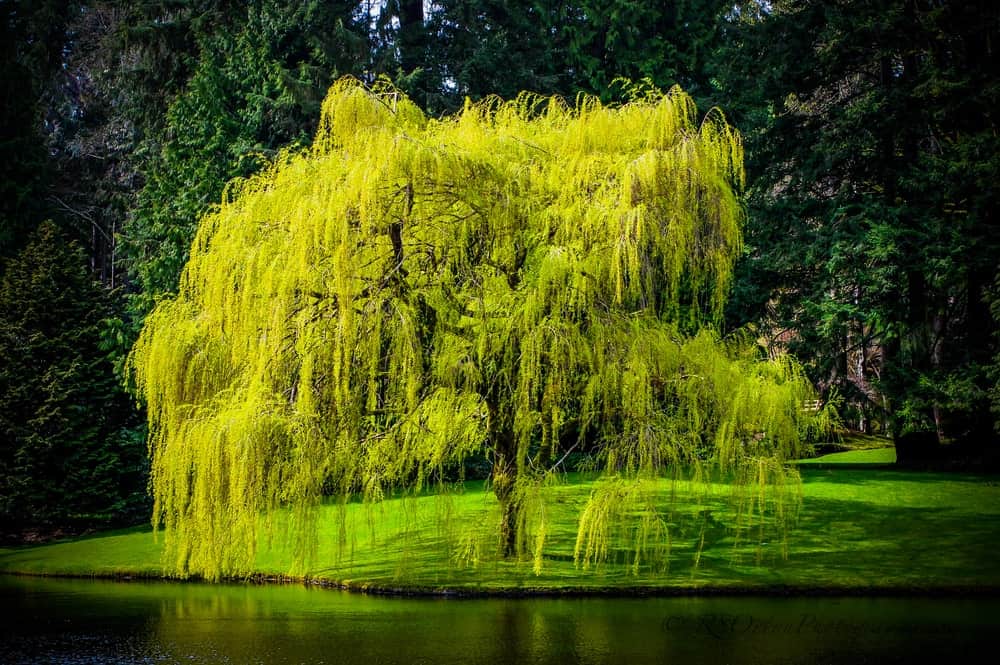Willow trees belong to a group of plants that love moisture, called the Salix genus.
There are more than 400 species of Willow trees and shrubs, all mostly Winter trees.
They can easily tolerate the cold temperatures of Winter. All the willow trees do well in moist or wet soil, which helps them to grow correctly.
Some of the species might tolerate little dry conditions.
Most Willow trees are native to America, the USA, and Europe, whereas a few are native to Russia, China, Japan, and Korea.
Still, no matter where they are from, you can quickly grow them in your garden, following their proper instructions and care.
Caring is quite essential for these trees. Ensure they are not damaging your sewer lines and growing correctly.
You can find Willow shrubs, which are medium-sized and love the ground, and trees, which love the sky and are the tallest.
Willow trees have many kinds of leaves; some are thin and pointed, some are round with bent tops, some are narrow and wide, some are pale-colored, etc., ranging from 2 to 100 feet tall.
The Willow trees, being moisture-loving, are usually planted near streams, lakes, or ponds as they liven up the area and grow properly.
However, a few of these plants can also be planted in the main yard.
All you must be sure about is watering them regularly until they mature. Then, you can take shifts in watering them.
Characteristics of a Willow Tree/Shrub

- Height: The Willow can be a tree or a shrub, depending on your preference. The Shrubs range from 2-30 feet tall and come in a thicket form with multiple stems or attractive flowers. The Trees range from 50-100 feet tall with thin/thick branches and flexible wood.
- Bark: The bark of Willow trees contains a watery sap filled with salicylic acid, which is used as a pain reliever. The bark is soft, with slender branches and fibrous roots. Some species have narrow, long leaves; some are round, pointed at the end, and greenish purple-red. All trees/shrubs have different kinds of leaves growing on them.
- Flowers: All the Willow species are Dioecious, which means both male and female catkins grow on different trees. Both the catkins bloom early in the Spring Season before the leaves start to show up. The male catkins are of a different color, furrowed, and quite mesmerizing, whereas the females are generally green-colored.
- Temperature: Willow trees can grow the best at 32° since they require moist soil and full sunlight when they are juvenile. Even after they mature, they can get partial shade with their growth, and moist soil is always required.
- Types: Willows are of four types. Weeping willows have long, graceful, yet slightly weak stems that sway away in the breeze. Pussy Willows, which blooms the furry catkins that are perfect for display and feel like cotton candy. Gold or White Willows are used as shelters from other trees.
Different Willow Tree Lower Classifications
1. Yellow Willow

This is a shrub willow that may or may not take up the form of a tree.
It is native to Northern, Central, Southern America, and Central Canada. You can grow them both from the seeds or by transplanting them.
They take less time to mature and grow quickly in both cases. This is a winter tree that blooms flowers during Spring.
It helps repair areas affected by soil erosion, floods, etc.
Identification
- This tree grows up to 16 to 23 feet tall with an upright form. It grows near the meadows or the streams and at a fast rate. Make sure to have a space between this and the other trees.
- It produces yellow, green, and cream color flowers that are this tree’s exceptional quality and are considered as a Winter Deciduous tree. It also requires full sunlight for its growth.
2. White Willow

Native to Western, Central Asia, and Europe, this tree is enormous but has softwoods, making it non-likable by many people.
This tree is not planted everywhere, mainly in those areas where the wet spots can be covered.
It is known as White Willow because it produces white leaves underneath its vast size.
It also showcases a diamond feature that happens when it gets infected with fungi.
Because of its size, this tree needs a lot of space to grow, so we prefer to grow it far apart from other trees.
Identification
- This is one of the tallest growing Willow trees, measuring up to 50-100 feet with an irregular top. Its bark is grey-brown and gets wrinkly when it matures.
- The tree has slender oval leaves with fine silky white hairs below. The flowers bloom in early Spring, and male and female flowers bloom on different trees.
3. Weeping Willow

Weeping Willow trees are commonly found in Northern China and can grow in any landscape. It is called a Weeping tree because of its ground-sweeping branches.
This tree is mainly seen growing near the lakes or ponds as they brighten up the whole scenery, but they can also be planted in a large yard as the main tree.
This tree is not lifelong, so you must replace it every 30 years. It grows well near water and prefers acidic soil.
Identification
- This tree grows up to 35-50 feet tall quickly. It requires full sun and partial shade to grow. Make sure that it absorbs a medium amount of sunlight.
- This tree is filled with long, narrow leaves with pointed edges, yellow flowers that bloom during Summer, preferably in April-May, and brown fruit.
4. Scouler’s Willow
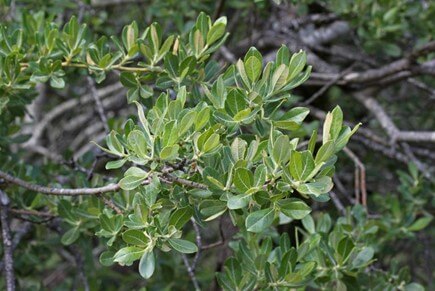
This tree is native to Western North America, Alaska, and the USA’s northern mountain states.
It is also known as black willow, fire willow, and western pussy willow.
This tree is planted near lakes or ponds to control soil erosion or as a hedge.
It will help if you are careful about a fire, as it will start to spread. It has a diamond characteristic like the White Willow and is famous for carving.
Identification
- This tree can grow up to 20-50 feet tall and requires full sun to partial shade for its proper growth. It can tolerate dry weather conditions better than the rest of the Willow trees.
- This tree’s leaves are narrow, egg-shaped, more expansive in the middle, dark green with pointed or round top, with yellow-green(young) to red-brown(matured) twigs.
5. Pussy Willow
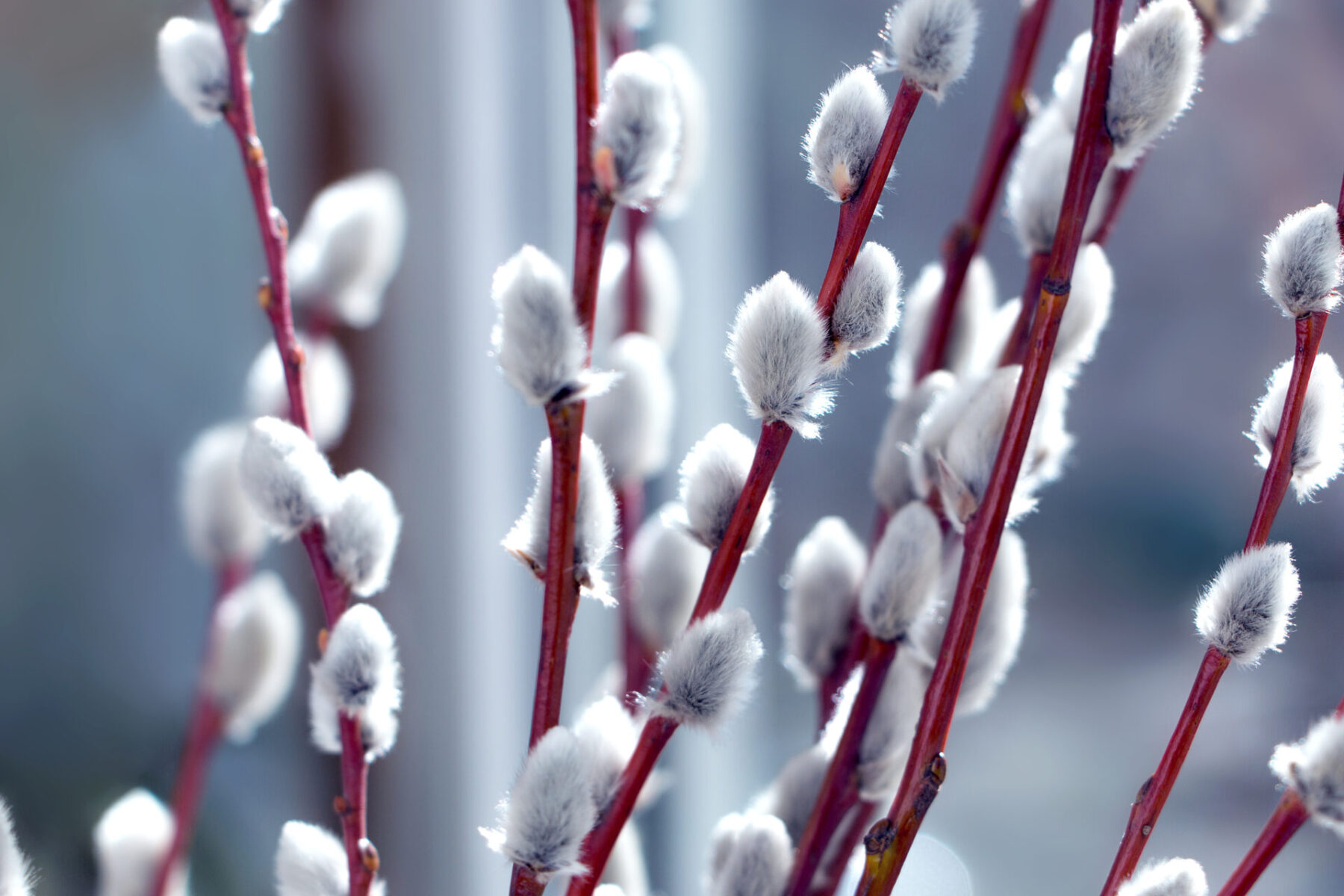
This American willow species is grown for its furry catkins(flowers) by the floral industry, but you can grow it in your yard.
It is native to North America, Canada, and the central USA. It is also known as American pussy willow, large pussy willow, and American Willow.
There are many pussy willow-like Japanese Pink Pussy Willow, Black Pussy Willow, and Rose-Gold Pussy Willow.
Identification
- Pussy willow includes both male and female plants, but the male plant produces different-colored furry flowers, which is the natural attraction. The female plants, however, produce green-colored flowers which look like hairy caterpillars.
- This water-loving plant is mainly planted near a lake or pond. If there is not enough rainfall, you must pour water on them. They can grow up to 2-25 feet tall, depending upon the type.
6. Purple Osier Willow
This type of shrub has purple stems, which is why it is called purple willow, and its leaves are blue-green when young.
You can even plant this as a hedge near the lakes and ponds to control erosion.
It is also called Basket Willow, Alaska Blue, and Purple Willow. This plant’s flowers and stems can be used for craft purposes, as they are impeccably beautiful.
Identification
- This plant grows up to 8-15 feet tall in a bushy form and requires full sun. Their trunk is light gray to brownish with thin bark and green, yellow, or reddish-purple twigs.
- This willow tree produces male and female catkins on different trees, and they bloom before the leaves. The male flowers are reddish-purple with silky hair, whereas the female flowers are greenish-yellow.
7. Peach-Leaf Willow
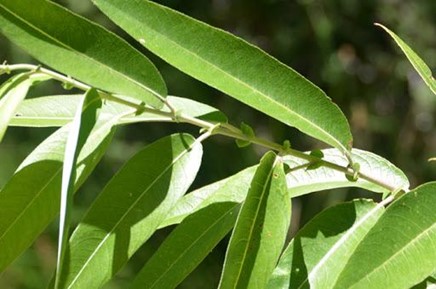
This tree is known as peach willow because it produces leaves resembling a peach tree.
You can only grow this plant with seeds, not by cutting since cutting through becomes difficult.
It helps control erosion and can be grown in bare areas of your yard. This tree is also known as Almond Willow and Wright Willow.
It is native to North America, the USA, and Southern Canada.
Identification
- This tree grows up to 30-50 feet at a fast rate. However, it is not a long-lived tree. It requires full sun to partial shade for its growth.
- The leaves of this tree resemble a lot like peach tree leaves. They are long, greenish-yellow on the top, and slender, while the underneath of the leaves is pale and silvery.
8. Goat Willow
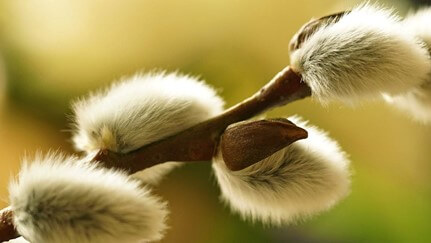
This willow tree is also known as Pussy Willow. It is a shrub or a small tree famous for its furry flowers.
You can also use this plant as a hedge or a filter plant if its pruning is done well enough in such a way that it looks attractive and grows well.
Like most trees, male and female flowers grow on different trees, so if you plant it for its catkins, you must plant both.
Identification
- This tree grows up to 12-30 feet tall and requires full sun and partial shade. The original trees grow in Western, Central Asia, and Europe. It is also known as Great Sallow, European/French Pussy Willow.
- The leaves of this tree are oval-shaped with a pointing end. Its flowers grow on different trees, and the male flowers are gray in color and oval-shaped. They turn yellow when it is ripped and resemble a cat’s paw, whereas the female flowers are more extended and greener.
9. Bebb Willow
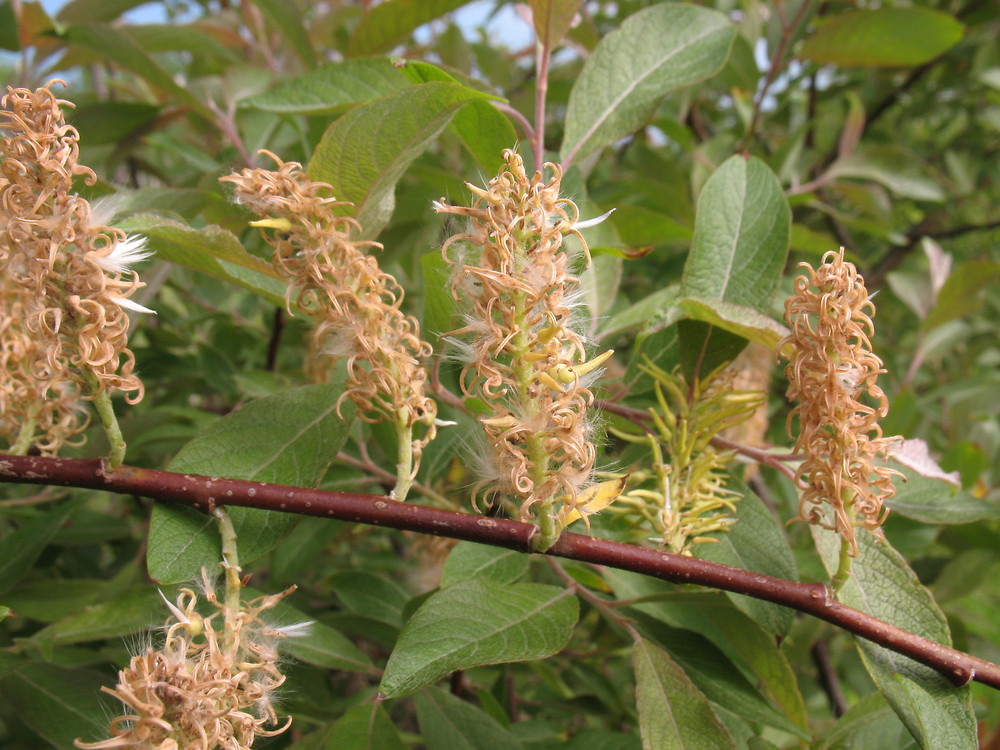
You will find this tree growing near lakes, ponds, or streams. It includes multiple stems and grows in thick bushes.
It can tolerate drought and is prone to diseases caused by insects. The wood of this tree is quite helpful for carving, and it can also be planted as a landscape tree other than controlling the lakes.
It is also known as Gray Will, Diamond Willow, and Long-Beaked Willow.
Identification
- Grown originally in the northern side of North America, this tree grows up to 10 to 30 feet tall and requires full sun to partial shade for its growth. Its bark is thin and red, olive green, or gray.
- This tree’s wood is diamond-shaped and used to make different kinds of furniture, lamps, candle holders, baseball bats, baskets, charcoal, gunpowder, etc.
10. Dappled Willow

This willow shrub produces multicolored flowers and is mainly grown as a display plant since it is suitable for that.
This tree grows best in rainy gardens or as a shrub bordering the yard since it includes multiple stems.
This plant is called Tricolor Willow, Japanese Dappled Willow, Nishiki Willow, and Japanese Variegated Willow.
Initially found in Russia, Japan, Korea, and Northeast China.
Identification
- It produces multicolored flowers. The juvenile flowers appear in a pink tone and are bloomed when the leaves start to appear. They then fade to white or green as they start to mature.
- This tree grows up to 4 to 6 feet tall and needs full sun to partial shade and moist, well-drained soil for its growth. This tree’s entire branch turns red after the leaves turn yellow and shed to the winter’s ground.
11. Corkscrew Willow
:max_bytes(150000):strip_icc()/corkscrew-willow-plant-profile-4844346-hero-67a00e6f5b1944ebae93b414aff03708.jpg)
The corkscrew willow is a multi-stemmed tree known for its twisting branches, which are a significant interest among the Winter trees.
This tree is called Curly Willow, Globe Willow, and Twisted Willow. The tree is found initially in Northeast China and can play a part in floral arrangements.
This tree is not long-lived and can be prone to insect or termite damage.
Identification
- This tree grows up to 20 to 50 feet tall and requires full sunlight and moist, well-drained soil. This tree loves moist soil, so you need to water it regularly during the first year at least and less afterward.
- The primary identification of this tree is its curly branches. Although they are a bit weak, they provide a great show during winter. It also produces long, silky leaves, which can be another noticeable part.
12. Narrowleaf Willow

This is another form of shrub willow. Narrow-leaf willow is planted as a display shrub.
It has a gray, furrowed bark used to make rustic furniture, which is quite popular in homes made from wood or even available homes with a rustic feature.
Other than that, it is also used to make building materials or poles.
You can find this shrub growing in all North America and from Alaska to Louisiana. It is also called Dusky Willow, Gray Willow, or Coyote Willow.
Identification
- This shrub grows up to 10 to 23 feet tall with a fast growth rate. It spreads itself from the shoots and forms petite colonies of thick shrubs. It requires full sun, moist soil to grow, and is not draught-tolerant.
- The leaves are broad and green, with silky white hairs when juvenile. It produces flowers on different trees after the leaves appear. Its most famous for its fruit, numerous seeds encompassed in shiny white silk.
13. Golden Willow
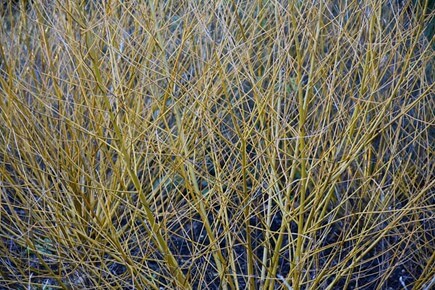
This multi-stemmed shrub has curly stems like the Corkscrew Willow tree and announces Winters’ arrival.
It requires full sunlight and partial shade for its growth and well-drained, moist soil.
This shrub is native to Europe, Central Asia, and Northern Africa. This shrub is planted near streams and lakes to control erosion.
Identification
- This shrub grows 6 to 30 feet tall and 5 to 25 feet wide. This shrub grows faster, can double its size, and becomes a medium-sized tree if you have not pruned it properly. So, if you want this shrub to be a shrub and not a tree, always prune them occasionally.
- This shrub has golden-colored stems that shine throughout the winter, and you have a shining shrub in your whole garden. This shrub has narrow, pointed leaves that turn yellow and fall when Fall arrives, revealing golden stems.
14. Black Willow
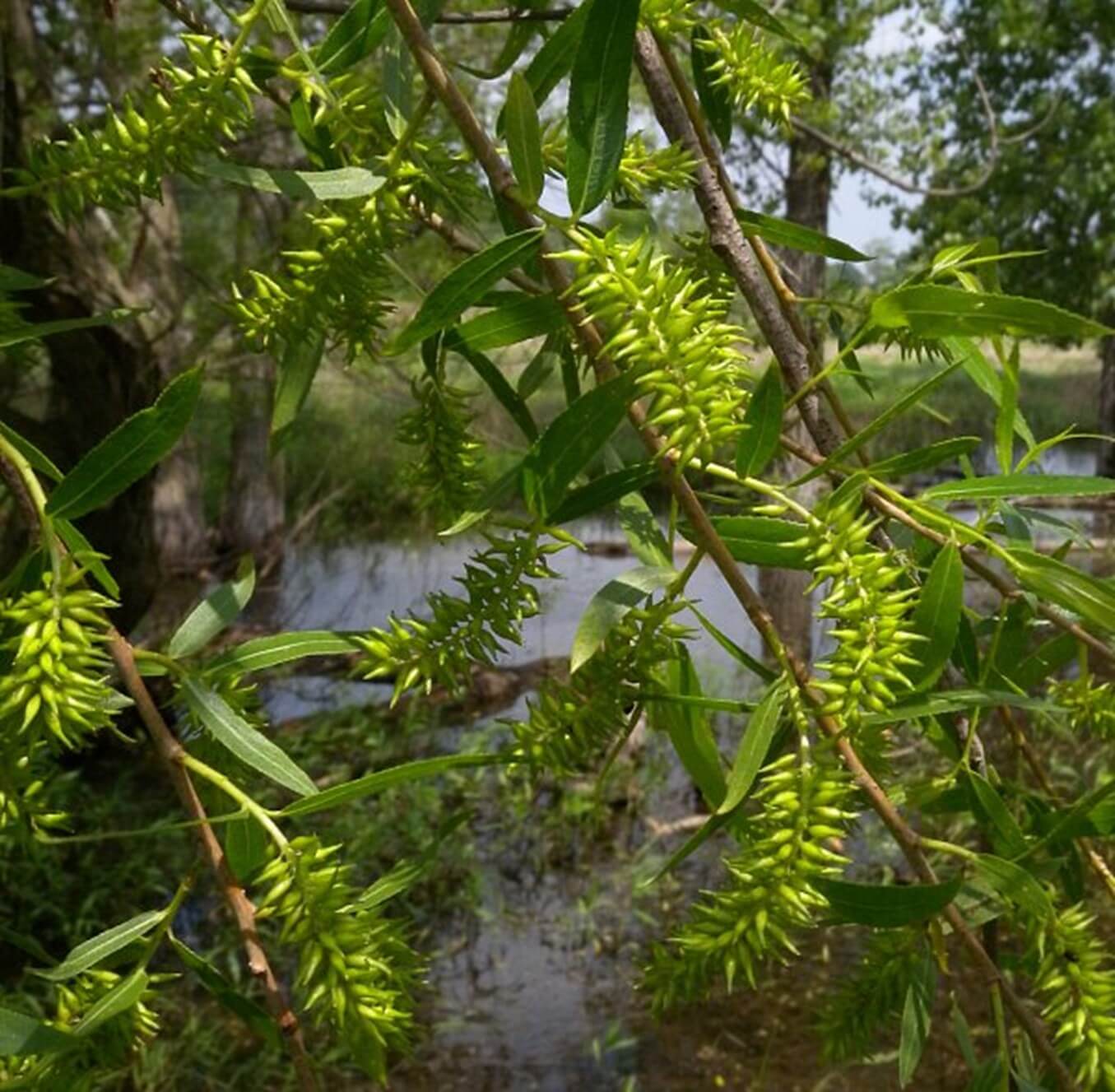
Native to all parts of Illinois, Black Willow is grown near the wetlands like swamps, lakes, etc., to prevent erosion.
The roots of this tree are invasive and can clog sewer lines. The wood of this tree is quite soft. A light, windy storm can damage that.
This tree requires moist soil but is short-lived, so you eventually must plant another tree in a few years.
Identification
- Black Willow grows 30 to 90 feet tall, with a stooping crown at the top. This tree produces either male or female flowers. Not both have bloomed. The male flowers are curve-shaped and yellow-green, whereas the female flowers are long, cylindrical, and of green color.
- The Black Willow is unique from other Willow trees because of its leaves. The leaves’ upper side is light to dark green in color and hairless, whereas the lower side is light green, hairless, but never pale like all the Willow trees are.
Conclusion
Willow Trees or Shrubs are of various types, each ranging in respect to their height, color, appearance, wood texture, flowers, leaves, and many more.
What is shared among all these species is that they are water-based species.
They are only grown near lakes, swamps, and rivers to prevent erosion from occurring. Very few of these make their way into the whole yard.
All of them require moist and well-drained soil to grow. They cannot survive in a dry climate or soil.
Even if you do not plant them near a water body, you must regularly water them to dry up quickly.
These trees produce attractive, breathtaking flowers or catkins; usually, the male flowers bloom beautifully, whereas the female flowers are mostly green and long.
Whatever shrub or tree you choose to grow, follow the essential facts for their growth.

